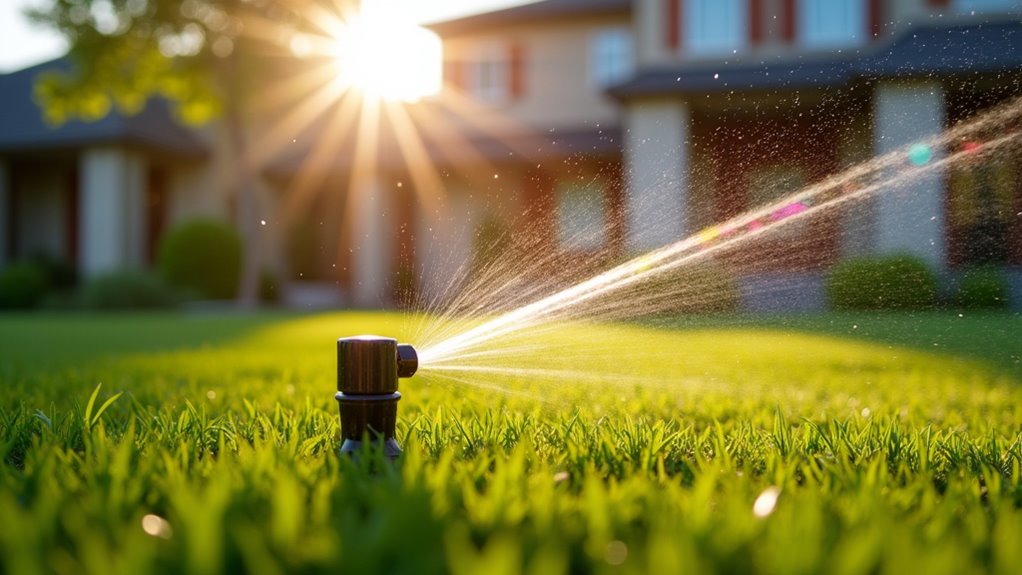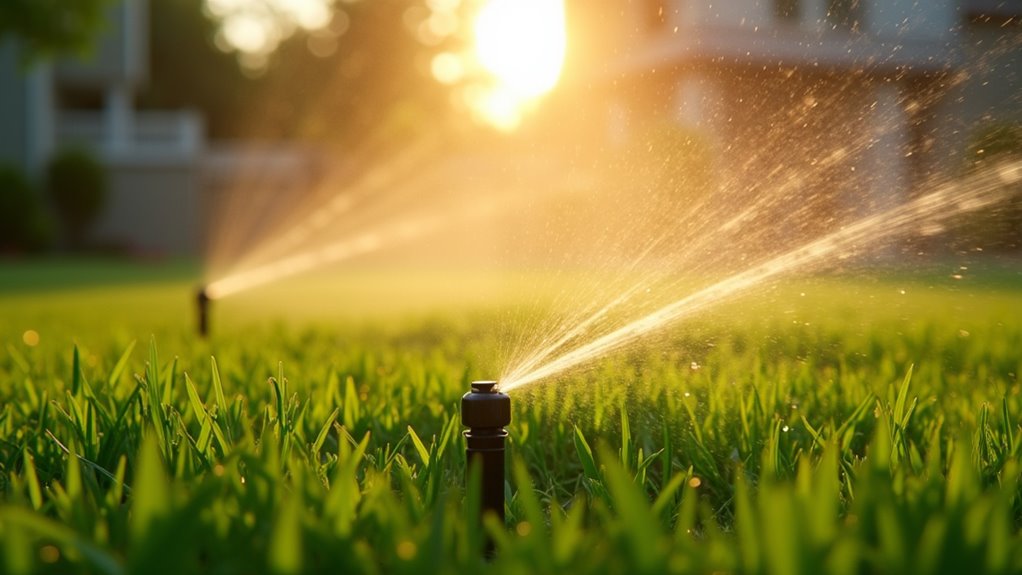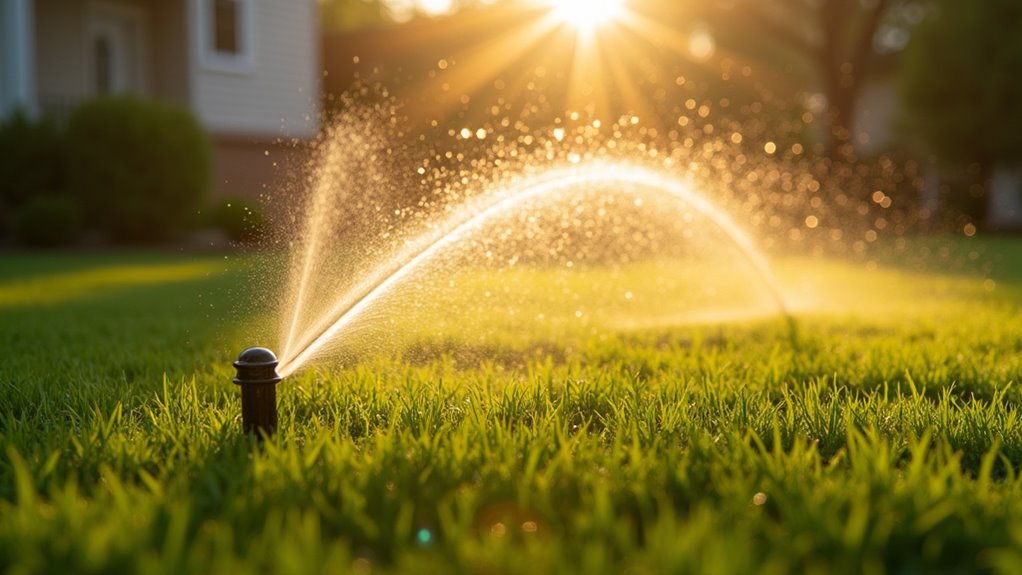Key signs your lawn needs lime include yellowing grass patches, widespread moss growth, and stubborn weeds like dandelions that thrive in acidic conditions. You’ll notice poor response to regular fertilizing despite proper application, as acidic soil prevents proper nutrient absorption. Your soil’s pH should ideally range from 6.0 to 7.0 – anything below 5.5 indicates severe acidity requiring immediate lime treatment. Understanding these indicators helps you take precise corrective action.
Yellow or Pale Green Grass Patches
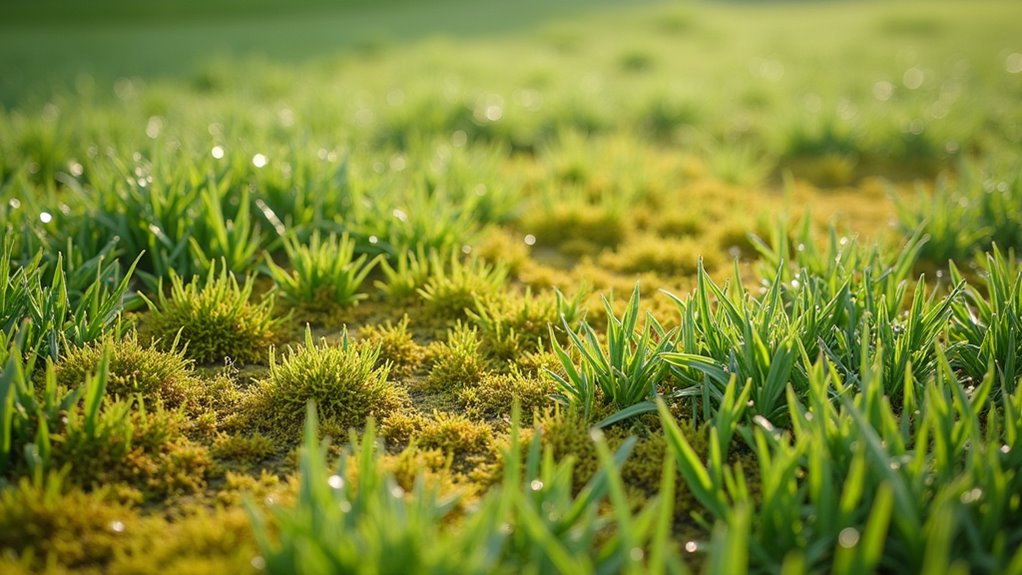
When your lawn begins displaying yellow or pale green patches, you’re likely dealing with acidic soil conditions that prevent proper nutrient absorption. These discolored areas serve as clear indicators that your Lawn Needs Lime treatment to correct the low soil pH levels that have fallen below the ideal range of 6.0 to 7.0.
If your grass continues showing signs of yellowing, don’t wait to take action. When soil pH drops below 5.5, essential nutrients become locked in the soil, making them unavailable to your grass. The best course of action is to conduct a soil test to determine the exact pH level. Once you have your soil test results, you can calculate the precise lime application needed to neutralize the acidic conditions and restore your lawn’s healthy green appearance.
Persistent Weed and Moss Growth
If you’re noticing widespread moss growth and persistent weeds like dandelions in your lawn, your soil is likely too acidic. Acidic soil conditions create an ideal environment for moss and weeds to thrive while preventing your grass from properly absorbing essential nutrients. A professional soil test will confirm if lime treatment is necessary to balance your soil’s pH and help your grass outcompete these unwanted invaders.
Moss Thrives in Acidity
Moss invasion in your lawn serves as a clear warning sign of acidic soil conditions that require lime treatment. When you notice moss outcompeting your grass, it’s a reliable indicator that your soil pH has become too low for ideal grass growth. This acidic environment creates unfavorable conditions for your lawn’s health while providing the perfect setting for moss to flourish.
To address this lawn problem, you’ll need to focus on adjusting your soil’s pH through strategic lime treatment. The presence of moss, particularly in shaded and moist areas, signals that your soil acidity is preventing proper nutrient availability for grass development. By applying lime, you can create a more balanced soil pH that supports exceptional grass growth while naturally suppressing moss establishment, ultimately restoring your lawn’s vigor.
Weeds Signal Ph Problems
Persistent weed invasion throughout your lawn provides compelling evidence of underlying pH imbalances that require lime treatment. When your lawn soil becomes too acidic, it creates ideal conditions for unwanted weeds while hampering nutrient absorption in your turfgrass. If you’re noticing increased weed growth, it’s time to test your soil pH and consider lime application as part of your lawn care strategy.
- Widespread dandelion and clover growth indicates highly acidic soil conditions
- Moss presence, especially in shaded areas, signals critically low pH levels
- Poor nutrient uptake in acidic soil allows weeds to outcompete your grass
- Regular soil testing helps identify pH issues before extensive weed invasion occurs
Poor Response to Regular Fertilizing
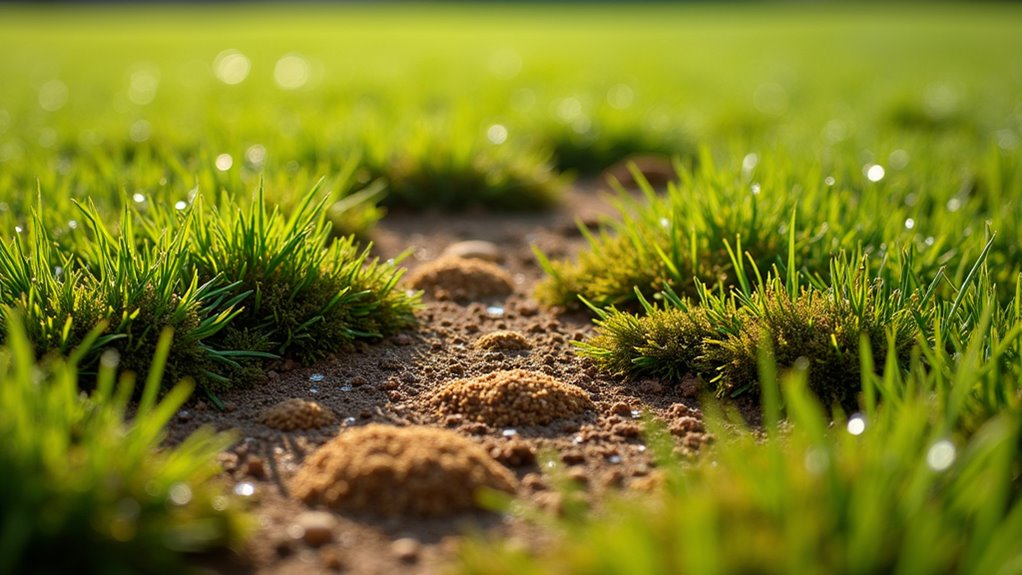
When your lawn consistently fails to green up despite regular fertilizer applications, you’re likely experiencing a nutrient lockout caused by acidic soil conditions. Your soil’s low pH prevents grass roots from properly absorbing essential nutrients, rendering your fertilization efforts ineffective. Continuing to apply fertilizers without addressing the underlying pH issue won’t solve the problem and may actually worsen soil acidity, making it critical to test your soil and apply lime if needed.
Fertilizer Absorption Issues
One of the most telling signs that your lawn needs lime is a poor response to regular fertilizer applications. When your soil’s pH is too acidic, your grass can’t properly absorb essential nutrients, regardless of how much fertilizer you apply. Ensuring your lawn maintains ideal pH levels is indispensable for effective nutrient uptake.
- Your grass shows persistent nutrient deficiencies despite regular fertilizing
- Acidic soil prevents roots from accessing crucial minerals and nutrients
- Fertilizer doesn’t seem to improve grass color or growth patterns
- Continued fertilization without pH correction may worsen existing problems
Before applying more fertilizer, consider soil testing to determine your soil texture and acidity levels. By identifying and correcting pH imbalances through lime application, you can restore your lawn’s ability to absorb nutrients back to optimal levels, making your fertilization efforts more effective.
Nutrient Lockout Problems
Despite regular applications of fertilizer, your lawn may experience nutrient lockout if the soil pH has become too acidic. When your soil test reveals a pH below 6.0, essential nutrients like nitrogen, phosphorus, and potassium become chemically bound to soil particles, making them unavailable to your grass roots.
This nutrient lockout creates a frustrating situation where continued fertilization won’t improve grass growth because soil acidity prevents proper nutrient absorption. If you’re applying fertilizer but seeing minimal results, you’re likely dealing with this pH-related issue. The solution isn’t more fertilizer – it’s addressing the underlying soil acidity through strategic lime application. Once you’ve corrected the pH level, your grass will regain its ability to absorb nutrients effectively, leading to a healthier lawn with improved growth response.
Soil Testing Results and Ph Levels
Understanding your soil’s pH level through testing is the foundation of effective lime treatment. When you test your soil, the results will help you comprehend how lime applications should be approached for your specific lawn. If your pH test reveals levels below 5.5, you’ll need to apply lime immediately to rectify high acidity. However, if your pH is already between 6.1 and 7.0, adding lime could be counterproductive.
- Test results showing pH below 5.5 indicate severe acidity requiring immediate lime application
- Moderately acidic soil (pH 5.6-6.0) benefits from calculated lime treatment
- Neutral to slightly acidic soil types (pH 6.1-7.0) typically don’t need lime
- Regular soil testing every 3-4 years maintains optimal pH
Remember that maintaining proper pH levels between 6.0 and 7.0 creates ideal conditions for most grass varieties to thrive.
Weather Impact on Soil Acidity
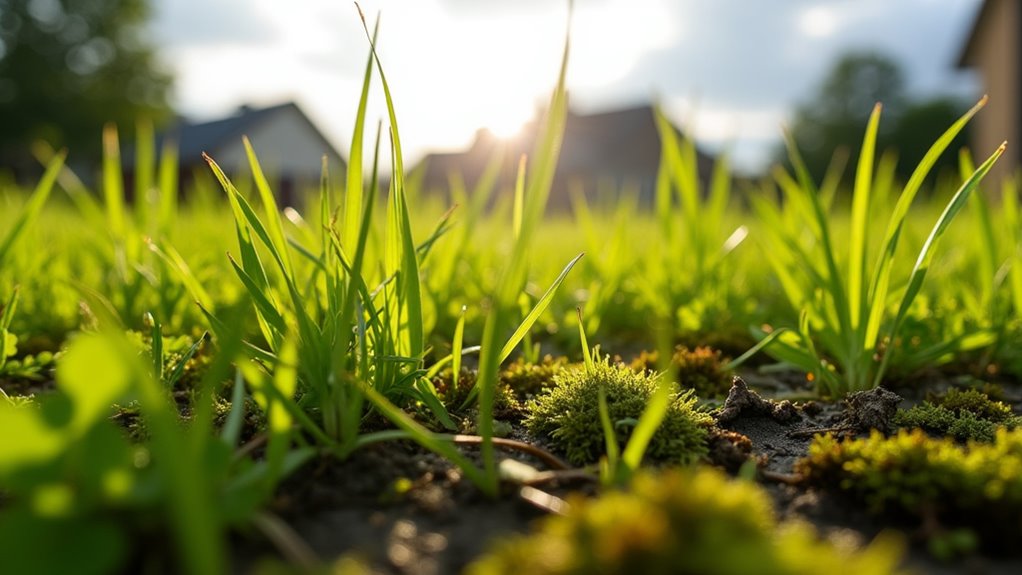
Weather patterns play a crucial role in determining your soil’s acidity levels and subsequent lime requirements. Heavy rainfall can leach essential soil nutrients like potassium, calcium, and magnesium, increasing soil acidity and necessitating more frequent lime application. You’ll need to monitor these changes closely through regular soil testing.
Seasonal changes in precipitation patterns directly affect your soil pH balance. If you’re in a region with consistent heavy rainfall, you’ll likely need to apply lime more often to maintain ideal lawn health. Conversely, during drought conditions, you might notice increased soil acidity that requires immediate lime treatment. In areas with limited rainfall, your soil may become more alkaline, reducing the need for lime applications. Understanding these weather-related fluctuations helps you adjust your lime treatment schedule effectively.
Clay and Sandy Soil Challenges
Both clay and sandy soils present unique challenges for maintaining ideal lawn pH levels. If you’re dealing with these soil types, you’ll need to monitor your soil’s pH carefully and apply lime regularly. Sandy soil rapidly loses calcium carbonate, while clay soil‘s dense structure makes it difficult for grass to access nutrients.
- Clay soil becomes highly acidic over time, requiring precise lime applications to improve nutrient availability and loosen compacted earth
- Sandy soil needs frequent lime treatments to maintain suitable pH and enhance its ability to retain water and nutrients
- A professional soil test will determine exactly how much lime your lawn needs, preventing over or under-application
- The benefits of proper lime application include improved soil structure, enhanced nutrient uptake, and prevention of moss growth
Regular soil testing and strategic lime treatments will help overcome these challenging soil conditions and promote healthier grass growth.
Best Practices for Lime Application
Proper timing and application techniques are critical for successful lime treatment of your lawn. The best time to apply lime is during fall or early spring when soil conditions aren’t frozen or drought-stressed. Before adding lime products, you’ll want to aerate your lawn to help the lime penetrate and work into the soil effectively.
To guarantee proper distribution, use a rotary or drop spreader to apply lime evenly across your yard. Follow the instructions from your soil test to determine the correct amount of lime needed. After application, thoroughly water your lawn to activate the lime and begin the pH adjustment process. Monitor your soil’s pH levels every 6-8 weeks following treatment, and make supplementary applications as needed to maintain ideal pH between 6.0 and 7.0.
Frequently Asked Questions
How Do I Know When My Lawn Needs Lime?
You’ll know your lawn needs lime by monitoring several key indicators. Watch for yellowing grass and increased weed infestation, which signal soil acidity levels are too high. Poor grass growth patterns and lawn discoloration often indicate soil nutrient imbalances. Check for reduced earthworm activity and excessive thatch accumulation. If you’re experiencing decreased water absorption and soil compaction, while maintaining regular mowing frequency, it’s time for a soil pH test.
What Is the Best Month to Lime Your Lawn?
You’ll get the best results by applying lime in March-April for spring application or September-October for fall application. Your specific timing should depend on your soil test results and ideal soil pH needs. While liming frequency varies, these months provide perfect conditions for lime granule size absorption and proper integration with your lawn’s organic matter content. Watch your grass growth patterns and lawn discoloration to confirm the treatment’s effectiveness after application.
What Does Grass Look Like That Needs Lime?
You’ll notice several visual indicators when your grass needs lime: discolored patches with yellowing leaves, thin grass growth creating an uneven texture, and bare spots throughout the lawn. Moss growth often appears in shaded areas, while weed overgrowth becomes more prevalent. Your grass will display slow growth patterns and shallow roots, leading to poor drought tolerance. These signs typically occur together, making it easier for you to identify lime deficiency.
How to Tell if Your Lawn Has Low Ph?
You can identify low soil pH balance through several key indicators. Watch for discolored grass blades that appear yellow or pale, along with inconsistent grass growth patterns across your lawn. Increasing moss growth and persistent weed invasion often signal soil acidity levels are too low. While home soil testing kits provide basic readings, professional tests offer precise measurements to determine proper lime application rates and help correct nutrient deficiencies through appropriate lime pellet distribution.

